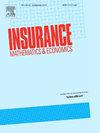Development of multimorbidity patterns in older adults in Switzerland: A competing risks modeling approach
IF 2.2
2区 经济学
Q2 ECONOMICS
引用次数: 0
Abstract
Multimorbidity, multiple long-term health conditions co-occurring in one individual, is a complex challenge that affects individuals, healthcare systems, and society. People with multimorbidity have a lower quality of life, higher mortality, and more complex needs and holistic treatments, resulting in higher health insurance and overall healthcare costs. Our study aims to investigate the progression of multimorbidity by identifying the main disease patterns in the adult population. Using an extensive dataset of health insurance claims from one of the largest Swiss health insurance companies, we categorize chronic long-term diseases into different pharmacy cost groups based on a medical classification system to assess the morbidity status of insureds. Developing on a competing risks framework, we use subdistribution hazard models adjusted for age effects to model key multimorbidity patterns, considering the most prevalent chronic diseases in the population. Our analysis focuses on estimating cumulative incidence functions for gender-specific trajectories. By shedding light on these patterns, our study contributes to a deeper understanding of multimorbidity dynamics and potential patient pathways. It provides information for decision-makers, financial planners, and healthcare professionals to enable optimal resource allocation and facilitate prevention and interventions tailored to the needs of various morbidity groups to reduce the disease burden and economic impact.
瑞士老年人多病模式的发展:一种竞争风险建模方法
多病,即在一个人身上同时发生多种长期健康状况,是一项复杂的挑战,影响个人、卫生保健系统和社会。患有多种疾病的人生活质量较低,死亡率较高,需要更复杂的整体治疗,从而导致更高的健康保险和总体医疗保健费用。我们的研究旨在通过确定成人人群中的主要疾病模式来调查多病的进展。使用来自最大的瑞士健康保险公司之一的健康保险索赔的广泛数据集,我们根据医疗分类系统将慢性长期疾病分类为不同的药房费用组,以评估被保险人的发病率状况。在竞争风险框架的基础上,考虑到人群中最普遍的慢性疾病,我们使用调整了年龄影响的亚分布风险模型来模拟关键的多发病模式。我们的分析侧重于估计性别特定轨迹的累积发生率函数。通过揭示这些模式,我们的研究有助于更深入地了解多病动力学和潜在的患者途径。它为决策者、财务规划人员和保健专业人员提供信息,以实现最佳资源分配,并促进针对不同发病率群体的需要进行预防和干预,以减少疾病负担和经济影响。
本文章由计算机程序翻译,如有差异,请以英文原文为准。
求助全文
约1分钟内获得全文
求助全文
来源期刊

Insurance Mathematics & Economics
管理科学-数学跨学科应用
CiteScore
3.40
自引率
15.80%
发文量
90
审稿时长
17.3 weeks
期刊介绍:
Insurance: Mathematics and Economics publishes leading research spanning all fields of actuarial science research. It appears six times per year and is the largest journal in actuarial science research around the world.
Insurance: Mathematics and Economics is an international academic journal that aims to strengthen the communication between individuals and groups who develop and apply research results in actuarial science. The journal feels a particular obligation to facilitate closer cooperation between those who conduct research in insurance mathematics and quantitative insurance economics, and practicing actuaries who are interested in the implementation of the results. To this purpose, Insurance: Mathematics and Economics publishes high-quality articles of broad international interest, concerned with either the theory of insurance mathematics and quantitative insurance economics or the inventive application of it, including empirical or experimental results. Articles that combine several of these aspects are particularly considered.
 求助内容:
求助内容: 应助结果提醒方式:
应助结果提醒方式:


